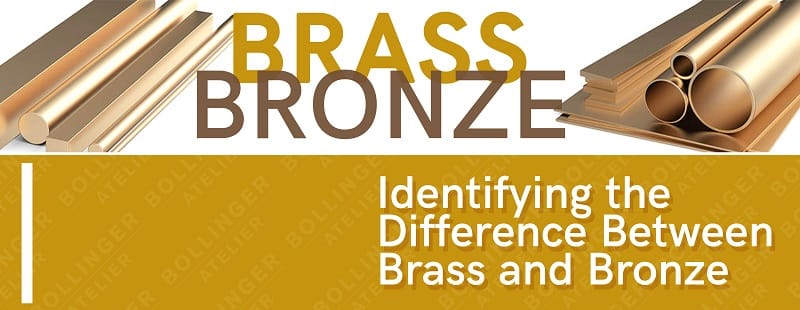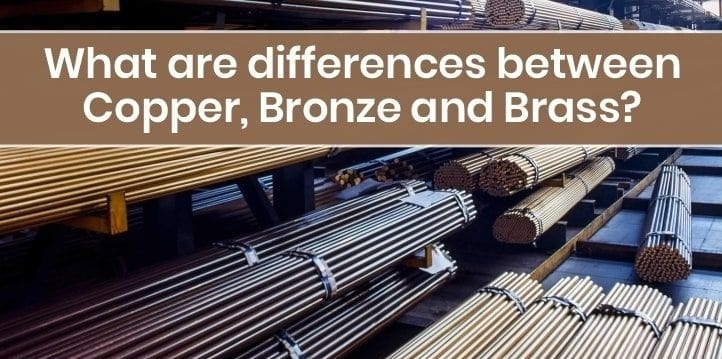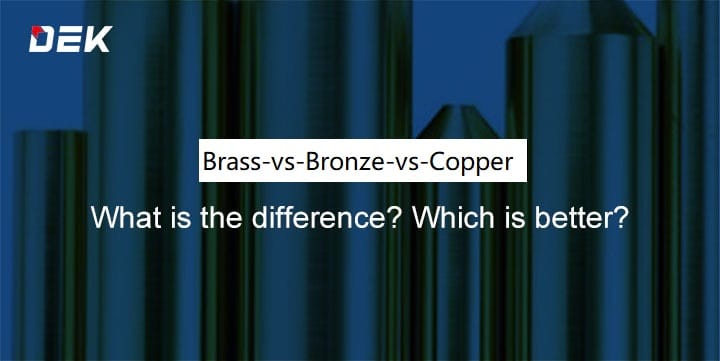Metal alloys have played a crucial role in human civilization, with Brass, Bronze, and Copper standing out as versatile materials with distinct characteristics.
Choosing the right metal for a specific application requires a nuanced understanding of their compositions, strengths, and weaknesses.
In this article, we delve into the intricate world of Brass, Bronze, and Copper, unraveling the complexities to help you make informed decisions.
Brass vs Bronze vs Copper: A Detailed Comparison

Brass: Composition and Characteristics
- Definition and Composition
Brass, a copper-zinc alloy, is celebrated for its unique blend of strength and malleability. Comprising varying proportions of copper and zinc, Brass exhibits a golden hue that makes it aesthetically appealing.
- Strengths and Weaknesses
Brass boasts excellent corrosion resistance and conductivity, making it ideal for electrical components and decorative items. However, it is susceptible to dezincification in certain environments, warranting careful consideration in specific applications.
- Common Applications
From musical instruments to plumbing fittings, Brass finds its way into diverse industries. Its antimicrobial properties also contribute to its use in healthcare settings.
Bronze: Unveiling the Alloy
- Composition and Historical Significance
Bronze, a copper-tin alloy, carries a rich historical legacy. Its use dates back to ancient civilizations, where it played a pivotal role in the development of tools and weapons. Today, modern bronze alloys may include other elements such as aluminum, manganese, or nickel.
- Strengths and Limitations
Bronze exhibits exceptional durability, making it a preferred choice for sculptures, bearings, and marine applications. However, it can tarnish over time, requiring maintenance to preserve its aesthetic appeal.
- Notable Uses in Various Industries
The marine industry relies on bronze for its resistance to corrosion in saltwater environments. Additionally, bronze is a popular choice in artistic creations due to its workability and timeless appeal.
Copper: The Versatile Metal
- Overview of Copper Properties
Copper, known for its reddish-brown hue, stands out as one of the oldest metals used by humans. Its excellent conductivity and ductility make it indispensable in various applications.
- Applications in Different Fields
Copper is a key player in electrical wiring, plumbing, and roofing. Its antimicrobial properties also find applications in healthcare settings, emphasizing its versatility.
- Sustainability Aspects
Copper is highly recyclable, contributing to its sustainability. The recycling process requires significantly less energy compared to primary production, making it an environmentally friendly choice.
Head-to-Head: Brass vs. Bronze vs. Copper

Comparative Analysis of Physical Properties
| Property | Brass | Bronze | Copper |
|---|---|---|---|
| Color | Yellow | Varies (typically reddish-brown) | Reddish-brown |
| Composition | Copper-Zinc | Copper-Tin (may include others) | Pure Copper |
| Strength | High | High | Moderate to High |
| Conductivity | High | Moderate to High | High |
| Corrosion Resistance | Good | Good | Excellent |
Applications in Construction and Manufacturing
When it comes to construction, Brass and Bronze are favored for their durability and aesthetic appeal. Copper, with its excellent conductivity, is a staple in electrical wiring and plumbing systems.
Durability and Corrosion Resistance
While Brass and Bronze offer good corrosion resistance, Copper outshines them with excellent resistance to corrosion. The choice depends on the specific environmental conditions and application requirements.
Factors Influencing Material Choice
Budget Considerations
Brass and Bronze are often more expensive than Copper due to the additional alloying elements. However, the longevity and unique properties of each material should be weighed against the upfront costs.
Aesthetic Preferences
The color and luster of Brass and Bronze make them popular choices for decorative items and artistic creations. Copper, with its distinct reddish-brown hue, adds warmth to architectural designs.
Environmental Impact
Consideration for the environment is increasingly crucial in material choices. Copper’s recyclability and minimal environmental impact make it a sustainable option. However, Brass and Bronze can also be recycled, contributing to a circular economy.
Strength Differences Between Brass, Bronze, and Copper

Choosing the right metal for a project involves considering various factors, and one critical aspect is the strength of the material. Brass, Bronze, and Copper are three metals with unique properties, and understanding their strength differences is essential for informed decision-making.
Brass: The Blend of Strength and Malleability
Brass, a copper-zinc alloy, strikes a balance between strength and malleability. Its strength is derived from the combination of copper and zinc, making it suitable for a wide range of applications.
Brass is known for its high tensile strength, allowing it to withstand considerable pressure without breaking. This characteristic makes it a popular choice in applications where both strength and formability are crucial.
Bronze: Exceptional Durability
Bronze, primarily a copper-tin alloy, is renowned for its exceptional durability. The addition of tin enhances its strength, making it suitable for heavy-duty applications.
Bronze is often chosen for its resistance to wear and corrosion, making it ideal for bearings, gears, and other components subjected to high stress. The strength of bronze, coupled with its corrosion resistance, contributes to its longevity in various industries.
Copper: The Conductor with Moderate Strength
Copper, in its pure form, is known for its excellent conductivity but has only moderate strength. While it may not match the tensile strength of Brass or the durability of Bronze, copper’s strength lies in its electrical conductivity.
It is commonly used in electrical wiring, where its moderate strength is sufficient, and its high conductivity is paramount. Copper’s ability to bend without breaking also adds to its versatility in certain applications.
Comparative Analysis of Strength
| Property | Brass | Bronze | Copper |
|---|---|---|---|
| Tensile Strength | High | High | Moderate |
| Hardness | Varies | High | Moderate |
| Ductility | High | Moderate | High |
Tensile Strength
Brass and Bronze exhibit high tensile strength, suitable for applications requiring resistance to pulling forces. Copper, while not as strong, still offers moderate tensile strength that meets the needs of specific applications.
Hardness
Bronze stands out with high hardness, contributing to its wear resistance. Brass, depending on the alloy composition, can have varying hardness. Copper, in its pure form, is relatively softer compared to Brass and Bronze.
Ductility
Both Brass and Copper are known for their high ductility, allowing them to undergo significant deformation without breaking. Bronze, while less ductile than Brass and Copper, still maintains a moderate level of ductility.
The choice between Brass, Bronze, and Copper ultimately depends on the specific strength requirements of the project. If high tensile strength and malleability are crucial, Brass is a suitable choice.
For applications demanding exceptional durability and hardness, Bronze is the preferred option. Copper, with its moderate strength and excellent conductivity, is ideal for electrical and certain structural applications.
Understanding the nuances of each metal’s strength characteristics ensures that you select the right material for your project, optimizing performance and longevity.
What Are The Benefits of Brass, Bronze, and Copper?

Choosing the right material for a project involves a careful consideration of various factors, and Brass, Bronze, and Copper are three metals that offer a myriad of benefits. Each metal comes with its unique set of advantages, making them indispensable in a wide range of applications.
Let’s explore the benefits of Brass, Bronze, and Copper, shedding light on their distinct qualities.
Brass: The Golden Alloy
1. Corrosion Resistance: Brass exhibits excellent resistance to corrosion, making it a durable choice for various applications. This characteristic is particularly valuable in environments where exposure to moisture or harsh conditions is a concern.
2. Aesthetic Appeal: With its golden hue, Brass adds an aesthetic touch to architectural and decorative elements. It is a favored material for crafting elegant fixtures, musical instruments, and intricate art pieces.
3. Malleability: Brass is highly malleable, allowing it to be easily shaped and formed. This property makes it ideal for intricate designs in jewelry, statuary, and ornamental details.
4. Antimicrobial Properties: Brass possesses natural antimicrobial properties, making it a hygienic choice for items in healthcare settings. This characteristic adds an extra layer of safety in applications like doorknobs and handrails.
Bronze: The Timeless Alloy
1. Durability and Hardness: Bronze is celebrated for its exceptional durability and hardness. This makes it an ideal choice for applications where wear resistance is crucial, such as bearings, gears, and sculptures that withstand the test of time.
2. Corrosion Resistance: Similar to Brass, Bronze offers excellent resistance to corrosion. This feature contributes to its longevity in marine environments and outdoor installations.
3. Artistic Appeal: Bronze has been a favorite of sculptors and artists for centuries due to its ability to capture intricate details. Its warm, earthy tones and patina over time add to its timeless aesthetic appeal.
4. Low Friction: Bronze’s low friction characteristics make it suitable for bearings and bushings, reducing wear and extending the lifespan of mechanical components.
Copper: The Versatile Conductor
1. Excellent Conductivity: Copper is renowned for its exceptional electrical conductivity, making it the go-to material for electrical wiring and components. Its low electrical resistance ensures efficient transmission of electricity.
2. Thermal Conductivity: In addition to electrical conductivity, copper also boasts high thermal conductivity. This property is advantageous in applications where efficient heat transfer is essential, such as in heat exchangers and cookware.
3. Ductility: Copper is highly ductile, allowing it to be easily drawn into thin wires. This property is critical in the production of fine electrical wires used in various electronic devices.
4. Recyclability: One of Copper’s significant benefits is its recyclability. The recycling process requires significantly less energy compared to primary production, making it an environmentally friendly choice.
Brass vs Bronze vs Copper: Which One Should You Choose?

Choosing the right metal for a project is a critical decision, and the selection often comes down to Brass, Bronze, and Copper. Each of these metals brings its own set of characteristics to the table, making them suitable for different applications.
In this chapter, we’ll explore the distinctions between Brass, Bronze, and Copper to help you make an informed choice based on your specific needs.
Brass: The Versatile Alloy
Composition: Brass is primarily a copper-zinc alloy, with varying proportions of these metals influencing its properties. The addition of other elements, such as lead or tin, can further modify its characteristics.
Strengths:
- Corrosion Resistance: Brass exhibits good corrosion resistance, making it suitable for applications in moist or corrosive environments.
- Aesthetic Appeal: With its golden hue, Brass is a popular choice for decorative elements and artistic creations.
- Malleability: Highly malleable, Brass can be easily shaped and formed into intricate designs.
Applications:
- Plumbing fittings
- Musical instruments
- Decorative items
- Electrical connectors
Bronze: The Timeless Alloy
Composition: Bronze is primarily a copper-tin alloy, but it can include other elements like aluminum, manganese, or nickel, depending on the desired properties.
Strengths:
- Durability: Bronze is known for its exceptional durability, making it suitable for applications where longevity is crucial.
- Corrosion Resistance: Similar to Brass, Bronze offers excellent resistance to corrosion, contributing to its longevity.
- Artistic Appeal: Bronze’s warm, earthy tones and ability to capture fine details make it a preferred choice for sculptures and artistic creations.
Applications:
- Bearings and bushings
- Gears
- Sculptures
- Marine applications
Copper: The Conductor of Choice
Composition: Copper is a pure metal, known for its reddish-brown hue. Its properties can be influenced by the addition of other elements, such as phosphorus.
Strengths:
- Electrical Conductivity: Copper is renowned for its exceptional electrical conductivity, making it a staple in the electrical and electronics industries.
- Thermal Conductivity: High thermal conductivity makes copper ideal for applications where efficient heat transfer is essential.
- Ductility: Copper is highly ductile, allowing it to be drawn into thin wires for various applications.
Applications:
- Electrical wiring
- Plumbing pipes
- Heat exchangers
- Cookware
Choosing the Right Metal for Your Project
Considerations:
- Corrosion Resistance: If your project involves exposure to moisture or corrosive environments, both Brass and Bronze are excellent choices.
- Aesthetic Requirements: If aesthetics play a significant role, Brass and Bronze, with their distinct colors and luster, offer a timeless appeal.
- Strength and Durability: For applications requiring high strength and durability, especially in heavy-duty settings, Bronze may be the preferred choice.
- Conductivity: In electrical applications where conductivity is paramount, Copper is the go-to metal.
Final Decision:
- Choose Brass if: You need a versatile, corrosion-resistant metal with an appealing golden hue for decorative and functional applications.
- Choose Bronze if: Durability and wear resistance are paramount, particularly in applications like bearings, gears, or artistic creations.
- Choose Copper if: Exceptional electrical and thermal conductivity are crucial for your project, such as in electrical wiring or heat transfer applications.
Navigating the Brass vs Bronze vs Copper dilemma requires a careful consideration of your project’s specific requirements. Each metal has its unique strengths, and the right choice depends on factors such as corrosion resistance, aesthetics, and desired physical properties.
Whether you’re crafting a piece of art, designing electrical components, or selecting materials for structural applications, understanding the distinct characteristics of Brass, Bronze, and Copper empowers you to make the best choice for your project’s success.
FAQs About Brass Vs. Bronze Vs. Copper

What Distinguishes Brass from Bronze and Copper?
Brass is a copper-zinc alloy, Bronze is a copper-tin alloy, and Copper is a pure metal. Each has distinct properties that make them suitable for specific applications.
Are There Specific Industries Where One Metal Is Favored Over the Others?
Yes, for example, the marine industry often favors Bronze for its corrosion resistance, while electrical wiring commonly utilizes Copper due to its high conductivity.
How Do Environmental Concerns Play a Role in Choosing Between Brass, Bronze, and Copper?
Copper stands out as a sustainable option due to its recyclability and minimal environmental impact. However, Brass and Bronze can also be recycled.
Can These Metals Be Used Interchangeably in Certain Applications?
While there may be some overlap, each metal has unique properties that suit specific needs. It’s crucial to consider factors like corrosion resistance, conductivity, and aesthetic appeal.
Are There Any Upcoming Innovations in the Field of Metal Alloys?
Advancements in nano-alloys and composite materials show promise in enhancing the properties of Brass, Bronze, and Copper. Keep an eye on emerging technologies for future applications.
Conclusion
In the intricate world of Brass, Bronze, and Copper, each metal tells a unique story of durability, versatility, and aesthetic appeal. As you navigate the choices for your projects, consider the specific needs, environmental impact, and long-term benefits.
Whether you opt for the timeless elegance of Brass, the historical significance of Bronze, or the versatile functionality of Copper, these metals are sure to stand the test of time.

